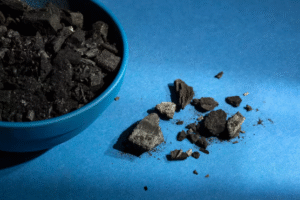
When it comes to heating your home efficiently and economically, coal has long been one of the most reliable fuels. However, with growing environmental awareness and changes in regulations, many homeowners are asking: Is smokeless coal better than traditional coal? Both have their advantages and drawbacks, but the right choice depends on your heating needs, environmental concerns, and cost considerations.
In this comprehensive guide, we’ll explore the key differences between smokeless coal and traditional coal, their benefits, efficiency, environmental impact, and how each performs in domestic heating systems.
1. What Is Traditional Coal?
Traditional coal, often called bituminous coal, is a black or dark-brown sedimentary rock formed from ancient plant matter. It has been a popular heating fuel for centuries due to its high heat output and affordable price.
However, traditional coal contains volatile compounds and impurities such as sulfur, which cause smoke, soot, and harmful emissions when burned. This is why areas with air quality restrictions often limit or ban its use in domestic fireplaces and stoves.
Traditional coal can be found in several grades, but bituminous and anthracite are the most common. Anthracite is harder, has a higher carbon content, and burns cleaner than bituminous coal, but it is still not considered “smokeless.”
2. What Is Smokeless Coal?
Smokeless coal is a modern alternative designed to offer efficient heating with minimal smoke and reduced environmental impact. It is made from refined natural coal or manufactured fuels such as ovoid briquettes, which are pressed and treated to reduce volatile materials.
Smokeless coal burns at a higher temperature and produces far less smoke, ash, and soot compared to traditional coal. It’s also authorised for use in Smoke Control Areas, making it suitable for urban and suburban households that must comply with clean air regulations.
There are two main types of smokeless coal:
Natural smokeless coal (Anthracite-based): Naturally low in volatile compounds.
Manufactured smokeless coal (briquettes): Engineered using carbon-rich materials and binding agents for consistent, clean burning.
3. Key Differences Between Smokeless Coal and Traditional Coal
Let’s break down the main differences between these two types of fuels:
| Feature | Smokeless Coal | Traditional Coal |
|---|---|---|
| Smoke Production | Very low or none | Produces heavy smoke |
| Carbon Emissions | Lower CO₂ output | Higher CO₂ output |
| Efficiency | Burns longer and hotter | Burns faster, less efficient |
| Ash Residue | Minimal ash | More ash and soot |
| Environmental Impact | Eco-friendly and compliant | Harmful emissions |
| Cost | Slightly higher | Usually cheaper |
| Storage Life | Long shelf life | Prone to dampness and crumbling |
| Legal Restrictions | Approved in most areas | Often restricted or banned |
From this comparison, it’s clear that smokeless coal is the cleaner and more efficient option, though it can cost slightly more upfront.
4. Heating Efficiency and Performance
One of the most important factors for any homeowner is how well the fuel heats the home.
Smokeless coal burns at a higher temperature and for a longer duration. Because it is denser and has a higher carbon content, it produces more heat per kilogram. This means fewer refills and less maintenance throughout the day.
Traditional coal, while also powerful, burns less efficiently. It may give off strong heat initially, but it tends to burn faster, resulting in more frequent refuelling and greater fuel consumption.
In terms of overall heating value, smokeless coal delivers better performance for modern heating systems, such as multi-fuel stoves and open fires.
5. Environmental Impact
Environmental impact is a key consideration for today’s homeowners. Traditional coal is notorious for releasing carbon dioxide (CO₂), sulfur dioxide (SO₂), and particulate matter, all of which contribute to air pollution and global warming.
Smokeless coal, on the other hand, is specifically designed to be environmentally responsible. It emits:
Up to 80% less smoke
Around 25% less carbon dioxide
Almost no visible soot
These properties make smokeless coal a much cleaner fuel that helps improve local air quality and reduce your carbon footprint.
If you live in an area governed by the Clean Air Act, only smokeless fuels are legally permitted for domestic burning. This makes smokeless coal the smart and compliant choice for most modern homes.
6. Ease of Use and Maintenance
Smokeless coal wins again when it comes to convenience and maintenance.
Because it burns more completely, it leaves behind less ash, which means less cleaning of your stove, flue, or chimney. The minimal smoke output also helps prevent soot buildup, reducing the frequency of chimney sweeping and maintenance costs.
Traditional coal, by contrast, produces significant soot and residue. Over time, this can clog your chimney, reduce airflow, and increase the risk of chimney fires if not cleaned regularly.
For busy homeowners who value a clean and low-maintenance heating experience, smokeless coal offers clear advantages.
7. Cost Comparison
At first glance, traditional coal appears cheaper per bag. However, that doesn’t tell the full story.
Since smokeless coal burns longer and hotter, you’ll need less fuel overall to achieve the same level of warmth. This efficiency often balances out the higher purchase price.
For example:
One bag of smokeless coal might last 25–40% longer than a bag of traditional coal.
Reduced soot and ash mean lower maintenance costs and fewer cleanings.
So, while the initial cost per tonne might be higher, the total cost of ownership for smokeless coal can actually be lower in the long run.
8. Storage and Handling
Both types of coal need proper storage to maintain their quality, but smokeless coal is less prone to deterioration.
Traditional coal can absorb moisture and crumble if stored improperly, especially outdoors. Damp coal burns poorly and emits even more smoke.
Smokeless coal, being denser and less porous, resists dampness better. It’s also typically packaged in sealed bags that make storage and handling easier.
For households with limited storage space, smokeless coal is a cleaner, tidier, and longer-lasting option.
9. Compatibility with Stoves and Open Fires
Most modern multi-fuel stoves and open fires are designed to burn smokeless fuels efficiently. Smokeless coal offers steady heat and clean combustion, which suits these systems perfectly.
Traditional coal, while still compatible with older fireplaces and grates, can damage modern appliances over time due to the tar and soot it produces.
If you’ve recently upgraded your stove or are planning to install a new heating system, smokeless coal is the recommended choice for long-term reliability and appliance health.
10. Air Quality and Health Benefits
The health implications of household fuel choices are often overlooked. Burning traditional coal releases fine particulate matter (PM2.5), which can lead to respiratory and cardiovascular issues when inhaled over long periods.
Smokeless coal emits far fewer particulates and almost no visible smoke, contributing to better indoor and outdoor air quality.
For families with children, elderly members, or anyone sensitive to air pollution, smokeless coal is a safer, healthier heating option.
11. Sustainability and Future Regulations
As global energy policies shift toward cleaner fuels, traditional coal is becoming increasingly regulated. Many regions have banned its sale or restricted its domestic use.
Smokeless coal, in contrast, meets the UK and EU environmental standards for domestic heating fuels. Manufacturers are also developing eco-friendly variants, incorporating renewable biomass materials to reduce carbon output even further.
Choosing smokeless coal today ensures your home remains future-proof and compliant with evolving environmental laws.
Conclusion: Which Is Better for Your Home?
When comparing smokeless coal vs traditional coal, the winner is clear — smokeless coal offers superior performance, cleaner burning, and greater efficiency. While it may cost slightly more upfront, the benefits far outweigh the difference in price.
Here’s a quick summary:
Cleaner Burning: Produces little to no smoke, protecting both the environment and your chimney.
Higher Efficiency: Burns hotter and lasts longer, saving you money over time.
Healthier and Safer: Reduces harmful emissions and indoor air pollution.
Legal and Future-Proof: Approved for use in smoke control zones and compliant with environmental standards.
Traditional coal may still have nostalgic or rural appeal, but for modern households concerned with efficiency, sustainability, and air quality, smokeless coal is undoubtedly the better choice.
In short, if you’re looking to heat your home effectively while caring for the environment — make the switch to smokeless coal. It’s a smart investment for both your comfort and the planet’s future.





